Satellite Imagery Analysis 2025/07/23
Preliminary Assessment of Iran’s Nuclear Development and the Attacks on Nuclear-Related Facilities
Yuki Kobayashi (Research Fellow, Sasakawa Peace Foundation)
1. Following Israel, the United States Launches Attacks on Iran’s Nuclear Facilities
On June 13, 2025, Israel initiated attacks on various locations within Iran, including nuclear-related facilities. Shortly thereafter, in the early hours of June 22 (local time), the United States conducted airstrikes on three Iranian nuclear-related sites. President Trump proclaimed the operation a success, boasting that the facilities had been “completely destroyed.”[1] Among the targeted locations were facilities embedded in rugged underground rock formations. The U.S. Department of Defense acknowledged using bunker-busting bombs—penetrating munitions capable of reaching and detonating deep beneath the surface.[2] Following these strikes, both Israel and Iran declared a ceasefire, effectively halting further attacks on Iranian nuclear facilities for the time being.
This coordinated operation aimed to prevent Iran from acquiring nuclear weapons. But what tangible results did it achieve? What kinds of nuclear-related facilities exist in Iran, and how far has its nuclear program progressed? These questions are essential to understanding the future trajectory of the region.
The Sasakawa Peace Foundation’s research project, “Study group of the international trends in the Nuclear Warhead Production Cycle,” employs satellite imagery analysis and other techniques to study the nuclear weapons production cycles of various nations. To address the questions above, members of the project team—including Tomonori Iwamoto, Secretary General of the Institute of Nuclear Materials Management (INMM)Japan chapter, who previously visited Iran’s Natanz uranium enrichment facility as part of an International Atomic Energy Agency (IAEA) inspection team, and Sho Tada, Associate Professor, Institute of Particle and Nuclear Studies, High Energy Accelerator Research Organization, with expertise in nuclear weapon structure and assembly—conducted a provisional assessment using satellite imagery, in light of the recent ceasefire.
2. Overview of Iran’s Nuclear Facilities and the Current State of Nuclear Development
(1). Iran’s Major Nuclear Sites
Table 1 lists Iran’s nuclear-related facilities. Three key characteristics of Iran’s nuclear activities are:
- Possession of technologies from natural uranium mining to uranium enrichment, enabling self-sufficient nuclear fuel production
- Advocacy for the “peaceful use of nuclear energy,” with a wide array of research facilities ranging from medicine to agriculture
- Restricted access to certain sites such as Fordow by the IAEA, raising concerns about intentions beyond peaceful purposes
Table1: Major Nuclear Facilities in Iran
| Facility Name | Overview |
|---|---|
| Tehran Nuclear Research Center | 5MWe research reactor, isotope production, multipurpose Jabbour Ibn Hayyan Research Lab |
| Kala Electric | The Atomic Energy Organization of Iran (AEOI)-affiliated firm; centrifuge testing |
| Isfahan Nuclear Technology Center |
Under AEOI; includes 3 Chinese-supplied small research reactors, uranium conversion plant, fuel fabrication facility, zirconium cladding factory |
| Bushehr Nuclear Power Plant | 1-million-kWe light water reactor owned by AEOI subsidiary; Russian-built; operational |
| Darkhovin Nuclear Power Plant | Under planning |
| Hormuz Nuclear Power Plant | Plan to build 4×1250MW reactors |
| Natanz Enrichment Facility | Commercial and test uranium enrichment plants; centrifuge assembly |
| Fordow Enrichment Facility | Uranium enrichment site |
| Karaj Agriculture & Medical Research Center | AEOI-affiliated; waste storage, medical isotope production |
| Shokar Abad Laser Enrichment Facility | AEOI laser enrichment lab (equipment dismantled and moved to Karaj) |
| Arak Complex | 40MWth research heavy water reactor, heavy water production |
| Kaveh Cutting Tools Company | Centrifuge manufacturing |
| Gachin Mine & Mill | Uranium mine and milling site |
| Saghand Mine | Uranium mine |
| Ardakan Mill | Likely mills uranium mined from Saghand |
| Jangasal Mine | Uranium mine |
| Narigan Mine | Uranium mine |
| Bonab Nuclear Research Center | Agricultural nuclear research |
| Faraayand Technic | AEOI firm; centrifuge production and quality control |
| Pars Trash | AEOI firm; centrifuge manufacturing |
Reference: Author’s compilation based on Citizens' Nuclear Information Center (CNIC)’s website “Nuclear and Atomic Facilities of Israel and Iran” (in Japanese)
Facilities targeted in the recent Israeli and U.S. strikes are shown in red: the uranium enrichment facilities at Natanz and Fordow, the nuclear technology center at Isfahan, and the Arak heavy water reactor (under construction). All are concentrated near Tehran (see Figure 1), and each plays a critical role in the production of nuclear materials essential for weaponization.
Figure 1: The locations of Iran’s nuclear-related facilities that were targeted in the recent Israeli and U.S. strikes
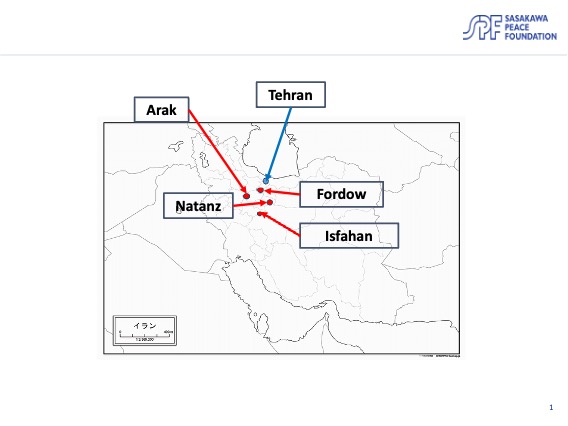
Source: Author’s compilation based on Nuclear Threat Initiative(NTI)「Country Spotlight: IRAN」
Natanz Uranium Enrichment Facility
Uranium enrichment is an indispensable process for the utilization of nuclear energy. Naturally occurring uranium contains only about 0.7% of uranium-235 (U-235), the isotope capable of sustaining a nuclear fission reaction and releasing vast amounts of thermal energy. The remaining 99.3% consists mainly of uranium-238 (U-238), which is not readily fissile. Therefore, technologies such as gas centrifuges are used to increase the proportion of U-235.
In practice, uranium ore is chemically processed into a yellow powder known as "yellowcake." This is then combined with fluorine to produce uranium hexafluoride (UF₆), which is heated to a gaseous state and fed into centrifuges for enrichment. As illustrated in Figure 2, low-enriched uranium (LEU), with a U-235 concentration of 3–5%, is commonly used in civilian nuclear reactors. Once this level of enrichment is mastered, it becomes technically feasible to produce highly enriched uranium (HEU) at 90% U-235 concentration, suitable for nuclear weapons. A uranium-type nuclear weapon typically requires approximately 22 kilograms of HEU per warhead.
Figure 2: Overview of Uranium Enrichment
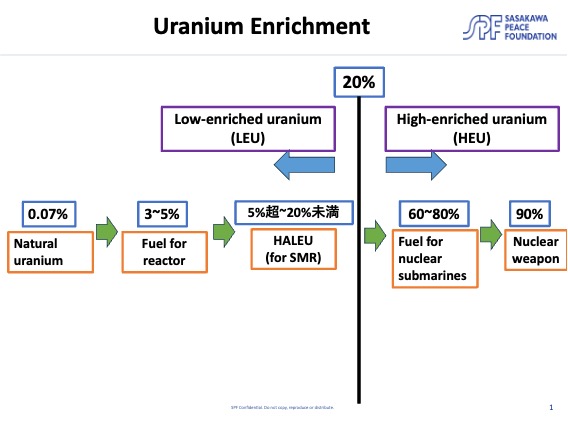
Source: Compiled by the author.
As Iran’s central hub for uranium enrichment, the Natanz site comprises the following components:
Table 2: Main facilities at Iran’s Natanz Uranium Enrichment Complex
| Facility | Function | Location |
|---|---|---|
| Test Enrichment Plant | Testing of new centrifuges | Above ground |
| Uranium Enrichment Plant | Commercial uranium enrichment | Underground |
| Centrifuge Assembly Facility | Manufacturing and assembly of centrifuges | Above and underground |
| Uranium Hexafluoride Storage | Storage of UF₆ feedstock for centrifuges | Above ground |
The test enrichment plant is primarily used to evaluate newly introduced centrifuge models. A few hundred centrifuges, ranging from early versions to more advanced ones, have been installed. According to IAEA estimates, the facility is capable of producing approximately 5–10 kg of 60% enriched uranium per month.
The commercial enrichment plant, mostly equipped with first-generation centrifuges, reportedly houses around 15,000 units. Based on IAEA assessments, it can generate 250–300 kg of 5% low-enriched uranium (LEU) monthly—suitable for civilian nuclear power. Additionally, the facility is believed to have the capacity to produce around 40–60 kg of 60% enriched uranium each month, raising proliferation concerns due to its proximity to weapons-grade enrichment levels.
Fordow Uranium Enrichment Facility
Fordow is known as the birthplace of Ayatollah Khomeini, the leader of the 1979 Iranian Revolution. The enrichment facility is located beneath a mountain, embedded 80–90 meters below solid bedrock.
Table 3: Key Facilities at Fordow
| Facility | Function | Location |
|---|---|---|
| Uranium Enrichment Plant | Commercial uranium enrichment | Underground |
| Research Laboratory | Production of medical radioisotopes, etc. | Underground |
The site houses approximately 2,800 centrifuges, of which 1,740 are advanced models. While the early-generation centrifuges are primarily made of aluminum alloys and copper, the newer models are constructed with carbon fiber, which improves both durability and efficiency. These advanced centrifuges are estimated to perform uranium enrichment tasks at five times the rate of the older models.
Due to restricted access by the IAEA, the full scope of Fordow’s operations remains unclear. However, based on the predominance of advanced centrifuges, nuclear expert Tomonori Iwamoto estimates that despite having far fewer centrifuges than Natanz, Fordow is capable of producing over 10 kilograms of 60% enriched uranium per month.
Isfahan Nuclear Technology Center
Isfahan plays a critical upstream role in Iran’s nuclear fuel cycle, housing facilities that precede uranium enrichment. It includes a uranium conversion plant and research reactors, which convert yellowcake into uranium hexafluoride (UF₆) for supply to enrichment sites such as Natanz and Fordow. Consequently, any disruption to operations at Isfahan would halt Iran’s ability to enrich uranium.
Additionally, Isfahan hosts a fuel plate fabrication facility, which produces fuel elements for the heavy water reactor discussed later.
Table 4: Key Facilities at Isfahan
| Facility | Function | Location |
|---|---|---|
| Uranium Conversion Plant | Converts yellowcake into uranium hexafluoride (UF₆) | Above ground |
| Fuel Plate Fabrication | Manufactures fuel plates for heavy water reactors | Above ground |
| Three Research Reactors | Neutron activation analysis and other applications | Above ground |
Arak Heavy Water Reactor
Table 5: Key Facilities at Arak
| Facility | Function | Location |
|---|---|---|
| 40MWth Research Heavy Water Reactor | Power generation; potential plutonium production | Above ground |
| Heavy Water Production Plant | Supplies moderator for the reactor | Above ground |
The classification of a nuclear reactor depends on the type of moderator used to slow down the release of neutrons during the fission process. A heavy water reactor uses heavy water (deuterium oxide), which has a higher density than ordinary water (light water), to fill the reactor core. This allows the reactor to use natural uranium as fuel without prior enrichment.
Unlike light water reactors, which account for roughly 80% of global civilian reactors—including those in Japan—heavy water reactors have a significant proliferation risk. When spent fuel from such reactors is reprocessed, it can yield plutonium-239, a fissile material suitable for nuclear weapons (see Figure 3). This type of plutonium is referred to as weapons-grade plutonium due to its high concentration of Pu-239.
Because of this potential, heavy water reactors are often viewed with concern from a nuclear non-proliferation standpoint. A notable precedent is India, which reportedly used a Canadian-supplied experimental heavy water reactor to produce plutonium for its first nuclear test.[4]
Figure 3 : Weapons-Grade Plutonium Isotopic Composition
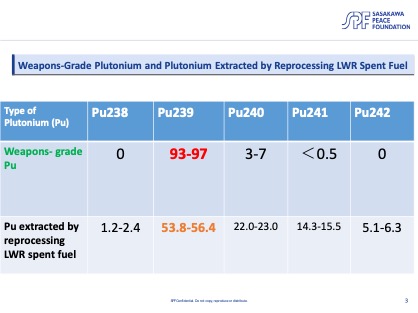
Source: Compiled by the author.
In August 2002, Iranian opposition groups revealed that Iran had been secretly constructing the Arak heavy water reactor, bringing international attention to the site.[5] In response to proliferation concerns, the Joint Comprehensive Plan of Action (JCPOA)—signed in 2015 between Iran and the P5+1 (the five permanent members of the UN Security Council plus Germany and the European Union)—included provisions to redesign the reactor so that it would no longer be capable of producing weapons-grade plutonium.
(2). Current Status of Iran’s Nuclear Development
Based on the operational status of Iran’s nuclear-related facilities, the following characteristics define the current state of its nuclear program:
- The program is centered on uranium enrichment, with Iran possessing a large stockpile of uranium enriched to 60%.
- Iran is believed to be capable of acquiring weapons-grade highly enriched uranium (HEU) within a matter of weeks.
- Iran has not acquired spent fuel reprocessing technology, and therefore cannot produce plutonium.
According to a report delivered by IAEA Director General Rafael Grossi to the United Nations Security Council on June 20, 2025, Iran’s stockpile of 60% enriched uranium exceeds 400 kilograms.[6]Under the Joint Comprehensive Plan of Action (JCPOA), uranium enrichment in Iran was restricted to the Natanz facility, with a maximum enrichment level of 3.67%. However, following the unilateral withdrawal of the Trump administration from the JCPOA in 2018, Iran began producing and storing uranium enriched to 60% from 2021 onward.
Iran officially claims that the purpose of enriching uranium to around 60% is to produce molybdenum-99 (Mo-99), a nuclear material used to generate technetium-99m (Tc-99m)—a radioisotope widely employed in medical imaging for detecting cancer and examining bones and organs.[7] According to nuclear expert Tomonori Iwamoto, “By burning uranium fuel enriched to over 60% in a reactor and reprocessing the spent fuel, high-quality Mo-99 can be obtained.”
However, even if Mo-99 production is the stated goal, it would require spent fuel reprocessing technology, which Iran has not yet acquired. This technical gap casts doubt on the feasibility of Iran’s medical justification and raises concerns about potential dual-use capabilities.
Regarding weapons-grade plutonium, Iran currently lacks the capability to produce it. The construction of the Arak heavy water reactor was suspended under the Joint Comprehensive Plan of Action (JCPOA). Iran has not yet acquired spent fuel reprocessing technology, which is essential for plutonium extraction.
These facts suggest two underlying strategic intentions behind Iran’s nuclear development:
- Maintaining uranium enrichment at 60% creates a technical setup whereby, with further enrichment, Iran could reach 90% weapons-grade uranium in approximately three weeks—should it choose to do so.
- By framing its program as medically oriented, Iran may seek future international acceptance—particularly from the IAEA and global stakeholders—to acquire reprocessing technology. This would enable Iran to eventually produce plutonium-based weapons material, if necessary.
According to nuclear expert Tomonori Iwamoto, the global supply of medical radioisotopes is insufficient. This makes Iran’s stated goal of producing molybdenum-99 (Mo-99)—used to generate technetium-99m (Tc-99m) for cancer and organ imaging—more palatable to the international community as a peaceful application of nuclear technology.
As previously noted, once Iran achieves 60% enrichment, reaching 90% is technically straightforward. By feeding its 400 kg stockpile of 60% enriched uranium back into centrifuges to remove non-U-235 isotopes, Iran could produce weapons-grade material. Assuming 22 kg of HEU per warhead, this stockpile could yield material for approximately 10 uranium-based nuclear weapons.
While a rudimentary nuclear explosive device could potentially be assembled within a few months, integrating such a warhead into missiles or aircraft would require additional steps—including nuclear testing, miniaturization, and delivery system adaptation—posing significant technical and strategic challenges.
3. Impact of the Attack: Satellite Imagery Analysis
Based on the status of Iran’s nuclear facilities and the current state of its nuclear development discussed in Section 2, the possible reasons for the Israeli and U.S. strikes on four facilities include:
- Preventing Iran from acquiring uranium-based nuclear weapons
- Blocking Iran’s ability to obtain plutonium in the future
Regarding the Natanz uranium enrichment facility, early Israeli strikes nearly completely destroyed the test plant and also damaged the power supply infrastructure. Subsequent Israeli attacks and analysis of satellite images following the U.S. military strike on the 22nd reveal the appearance of a new crater measuring over five meters in diameter. Although the satellite images cannot be presented due to licensing constraints, the underground structure at Natanz is considered less fortified than the Fordow site discussed later. It is possible that the large-scale underground commercial enrichment facility (see Table 1) was also destroyed. Additionally, the facility used for manufacturing and assembling centrifuges was likely damaged. Mr. Iwamoto assesses that “If the centrifuge assembly plant was destroyed, the impact on Iran would be more severe than the damage to the enrichment facility itself. It would significantly extend the time required to resume uranium enrichment activities.”
Satellite imagery taken after the strike on the Fordow site clearly reveals openings in craters, suggesting targeted impacts. In conjunction with the attacks on Natanz, the U.S. Department of Defense has confirmed that a total of 14 GBU-57 bunker buster bombs—among the heaviest in their class—were deployed.[8] The uranium enrichment facility at Fordow lies approximately 86 meters underground, while the GBU-57 is estimated to penetrate up to 60 meters. Given the shortfall in reach, it is believed that multiple bombs were dropped on the same location to maximize penetrative capability. However, the deeper portions of the crater remain obscured in satellite imagery, and there is disagreement among experts regarding the extent to which key equipment, such as centrifuges, was actually destroyed.
Figure 4: Bunker Buster drop strategy diagram
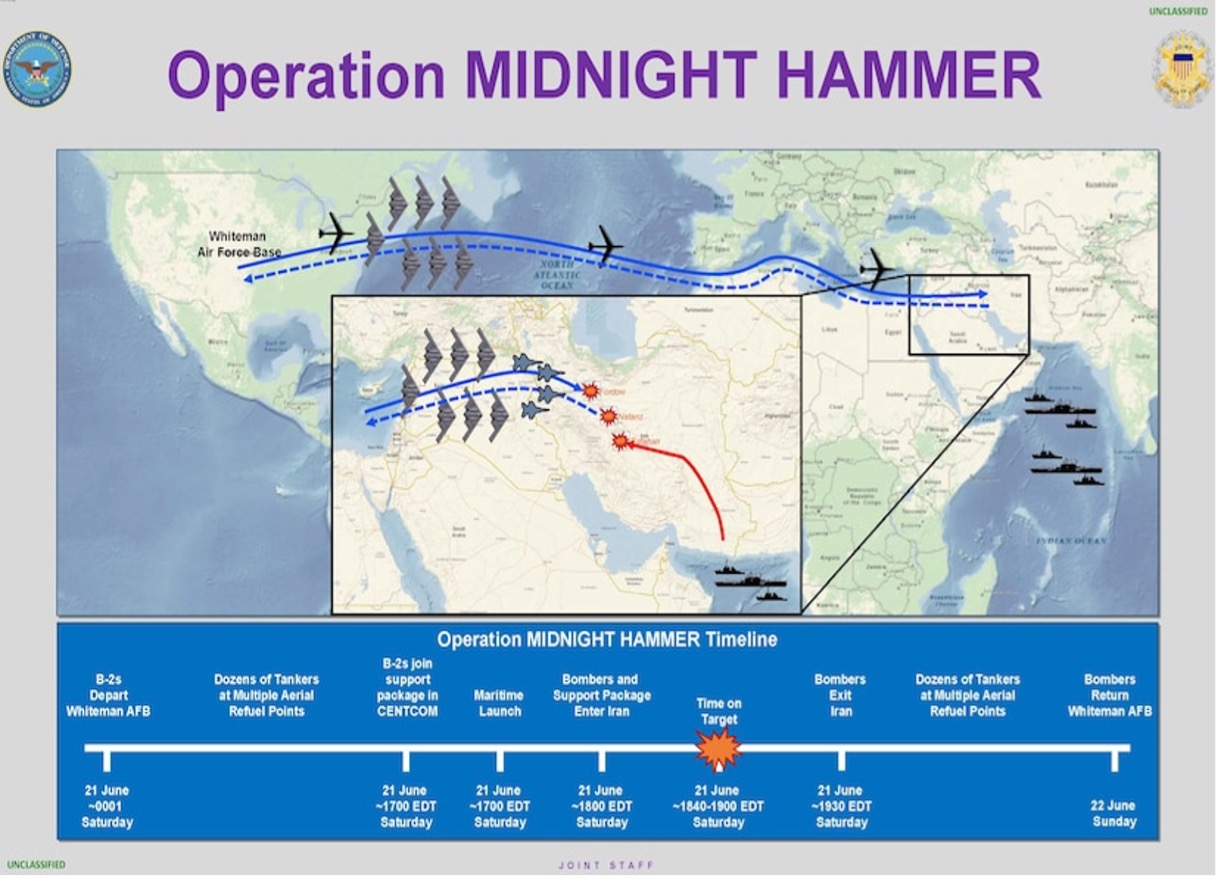
Source: Department of Defense “Hegseth, Caine Laud Success of U.S. Strike on Iran Nuke Sites” 22 June 2025.
President Trump confidently stated that the facilities were “completely destroyed.” In contrast, Chairman Dan Kane of the Joint Chiefs of Staff offered a more cautious perspective at the June 22 press briefing, remarking that “a final assessment of the operation’s success will require some time.”[9]Satellite imagery taken days prior to the attack clearly shows a convoy of trucks, suggesting that Iran may have relocated enriched uranium to a secure location. Based on this observation, some media outlets reported an initial assessment that the operation may have only delayed Iran’s nuclear weapons capability by a few months.
Taking these elements into account, Mr. Tada commented, “Although the U.S. military does not disclose the exact performance specifications of bunker buster bombs, the fact that they proceeded with the attack indicates a certain level of confidence. It’s possible that a significant level of destruction was achieved.” Mr. Iwamoto also noted, “Centrifuges are highly sensitive to vibration, so damage to Iran’s uranium enrichment capability is likely unavoidable.”
Among the affected sites, the destruction of building clusters in Isfahan is particularly notable. Prior to the attack, satellite images showed neatly arranged buildings with gray rooftops. In Satellite Image 1 below, more than ten structures appear to have been destroyed. This suggests a significant impairment to Iran’s capacity for producing uranium hexafluoride—a key precursor to uranium enrichment.
However, it's presumed that previously manufactured quantities may have been relocated in advance. If the underground uranium enrichment capabilities at Fordow have remained partially intact, enrichment activities could potentially continue. Aside from the facilities listed in Table 4, it is also believed that over 50% of Iran’s enriched uranium is stored in underground Isfahan-based structures, which do not show evidence of bunker buster deployment and thus appear unscathed.
Furthermore, as shown in the satellite imagery below, the operational research reactor remains undamaged. Article 56 of the First Additional Protocol to the Geneva Conventions prohibits attacks on nuclear power plants due to the risk of severe civilian harm. This indicates that both Israel and the United States were mindful of the provision and deliberately avoided striking the reactor, while aiming to diminish Iran’s broader nuclear development capabilities.
Satellite Image 1: Isfahan after the U.S. attack, June 22, 2025
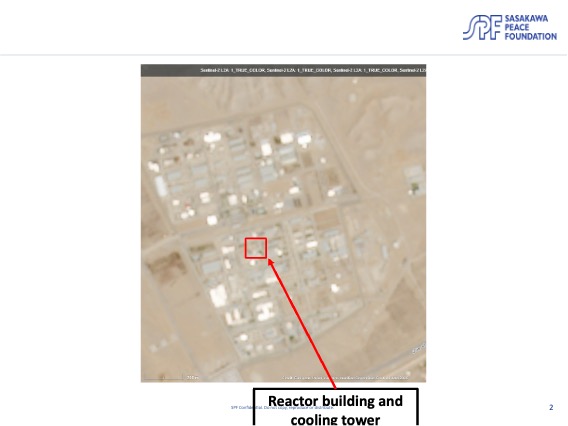
Source: Sentinel 2 Provided by CNIC, Hajime Matsukubo, Secretary General
The once orderly rows of gray-roofed buildings in Arak have been dramatically altered, with Satellite Image 2 revealing that nearly 70% of the facilities appear to have been damaged by the attack. The heavy water production units, marked in red, are reportedly in a state of ruin, while separate satellite imagery confirms a large breach in the reactor building—highlighted in blue—suggesting near-total destruction of critical infrastructure, including the reactor itself.
Fortunately, as fuel had not yet been loaded into the reactor, the risk of a large-scale radioactive leak is minimal. This likely led Israeli forces to judge the operation as compliant with international law, notably avoiding violations of the Geneva Conventions. In any case, the extent of damage suggests that Iran will face significant delays in acquiring weapons-grade plutonium for an extended period.
Satellite Image 2: Arak Nuclear Power Plant after U.S. airstrike, June 22, 2025
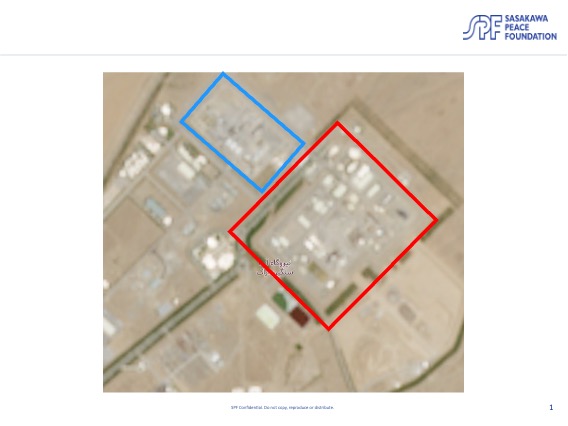
Source: Sentinel 2 Provided by CNIC, Hajime Matsukubo, Secretary General
4. Provisional Assessment of Israeli–U.S. Attacks and Future Outlook
Based on the satellite imagery analysis presented above, it is evident that U.S. involvement in the Israeli offensive significantly increased the level of facility damage. Prior to U.S. participation, Israel had already targeted locations such as the Islamic Revolutionary Guard Corps headquarters, government officials, and gatherings of scientists—delivering blows to Iran’s human capital and strategic decision-making apparatus related to nuclear development. Taken together, these actions clearly contributed to delaying Iran’s acquisition of nuclear weapons capabilities.[10]
Nevertheless, several factors point to the possibility that Iran’s nuclear development capacity has not been entirely eliminated:
- Initial analysis by U.S. defense intelligence suggests the operation may have only postponed Iran’s nuclear weaponization by several months, according to media reports.
- Enriched uranium was reportedly moved prior to the strike, and approximately 400 kilograms of 60% enriched uranium is believed to have survived undamaged.
- The centrifuges presumed to be destroyed were largely older-generation models, except for some units at Fordow.
Against this backdrop, Mr. Tada cautioned, “This attack could prompt Iran to both upgrade its centrifuge technology and shift toward plutonium production.”
To deter Iran from resuming its nuclear weapons program, the continuation of the ceasefire between Israel and Iran is crucial. Building on that, two measures should be pursued under the framework of the Treaty on the Non-Proliferation of Nuclear Weapons (NPT). The first is the prevention of further nuclear weapons proliferation. Should Iran withdraw from the NPT and pursue nuclear armament like North Korea, a “nuclear domino effect” could occur—prompting neighboring Middle Eastern nations such as Saudi Arabia to seek nuclear capabilities, and potentially influencing public sentiment in countries like South Korea, where pro-nuclear rhetoric has gained traction. In such a scenario, the credibility of the NPT as a multilateral treaty could be irreparably damaged.
Although the NPT has faced considerable challenges—including two consecutive failures to adopt a final agreement at review conferences[11]—there remains room for alignment among nuclear-armed and non-nuclear states regarding non-proliferation. Notably, as indicated in Table 1, China and Russia—countries with close nuclear cooperation ties to Iran through research reactor supply and commercial reactor construction—must take proactive steps to ensure the peaceful use of technologies they’ve provided. They should strongly urge Iran to remain within the NPT framework and collaborate closely with the IAEA to prevent military diversion.
Japan, though not a nuclear-weapon state, has been granted access to reprocessing technologies that allow it to extract plutonium from spent nuclear fuel. As such, Japan is well-positioned to encourage Iran to remain a member of the NPT and promote the peaceful use of nuclear energy in cooperation with the IAEA.
Looking ahead, the next critical challenge is pursuing the establishment of a Middle East nuclear-weapon-free zone, as envisioned in the “Resolution on the Middle East”[12] adopted during the 1995 NPT Review Conference. Thirty years after its adoption, the lack of tangible progress has fueled frustration among Middle Eastern nations and eroded confidence in the NPT framework. A particularly thorny issue remains how to engage Israel—believed to possess nuclear weapons outside the NPT regime—in dialogue toward denuclearization. However, given Iran’s continued stockpiling of highly enriched uranium, which shortens its breakout time to a nuclear weapon, this issue can no longer be sidestepped.
Japan, having maintained positive relations with Iran even after the 1979 Iranian Revolution, is well-positioned to contribute to regional stability. By drawing on its shared history of cooperation with the IAEA and potentially supporting negotiations toward a successor agreement to the JCPOA, Japan could play a meaningful role in shaping a peaceful nuclear future for the region.
1 WHITEHOUSE website “President Trump Delivers Address to the Nation” 21 June 2025”
[https://www.whitehouse.gov/videos/president-trump-delivers-address-to-the-nation-june-21-2025/]
2 U.S. Department of Defense “Hegseth, Caine Laud Success of U.S. Strike on Iran Nuke Sites” 22 June 2025.
[https://www.defense.gov/News/News-Stories/Article/Article/4222533/hegseth-caine-laud-success-of-us-strike-on-iran-nuke-sites/]
3 See, for example, "Processes at a Uranium Enrichment Plant," Japan Nuclear Fuel Limited website.
[https://www.jnfl.co.jp/ja/business/about/uran/summary/process.html]
4 Japan Atomic Energy Agency (JAEA), "Situation Concerning Nuclear Energy in India," April 2006.
[https://www.aec.go.jp/kaigi/senmon/mondai/siryo01/4_haifu.pdf]
5 Ministry of Foreign Affairs of Japan website, "Iran's Nuclear Issue," June 2004.
[https://www.mofa.go.jp/mofaj/gaiko/atom/iran_kaku.html]
6 IAEA website “IAEA Director General Grossi’s Statement to UNSC on Situation in Iran” 20 June 2025.
[https://www.iaea.org/newscenter/statements/iaea-director-general-grossis-statement-to-unsc-on-situation-in-iran-20-june-2025]
7 JAEA, Integrated Support Center for Nuclear Nonproliferation and Nuclear Security (ISCN), "Newsletter No. 0306," June 22, 2022.
[https://www.jaea.go.jp/04/iscn/nnp_news/attached/0306_en.pdf]
8 See footnote 2.
9 See footnote 2.
10 Japan Institute of International Affairs (JIIA), National Institute of Inquiry Strategic Comment (2025-12), Nobumasa Akiyama, "Tentative Assessment of the Impact of an Israeli Attack on Iran's Nuclear Program," June 15, 2025.
[https://www.jiia.or.jp/strategic_comment/2025-12.html]
11 For a discussion of recent NPT developments, see Sasakawa Peace Foundation/International Information Network Analysis IINA, my article, “NPT Regime on the Brink: Challenges for the Next Review Conference as Seen from Attendance at the Preparatory Meeting”, June 5, 2025.
[https://www.spf.org/iina/articles/yuki_kobayashi_20.html]
12 Nagasaki University Research Center for Nuclear Weapons Abolition, “Resolution on the Middle East”.
[https://www.recna.nagasaki-u.ac.jp/recna/database/importantdocument/un/no1/4-2]





